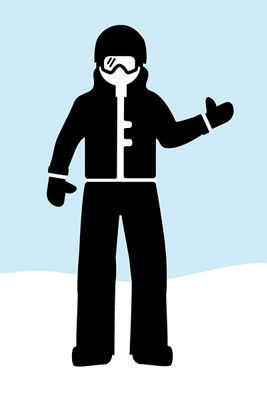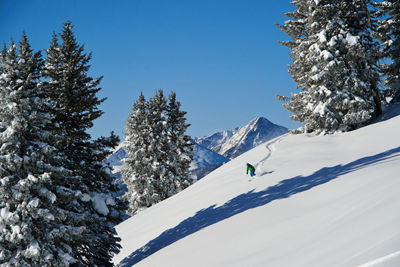Alpine Wellness

Wellness at Altitude
The same factors that make Keystone an experience like no other also have a flip side when it comes to your health and experience: our high altitude environment requires preparation, awareness, and acclimatization.
When you travel from a low altitude to a high one, your body needs time to adjust as it encounters less oxygen, colder temperatures, lower humidity, increased ultraviolet radiation, and decreased air pressure.
For most, altitude sickness symptoms will be mild and may include headaches, nausea, fatigue, loss of appetite, restless sleep, coughing, and difficulty in breathing. These can be easily alleviated with proper hydration and nutrition, but If symptoms persist beyond 1-3 days, seek medical attention.
Want our shortlist to avoid altitude sickness? Read on for more!

Gear to Bring
- Helmet: protect your brain, keep your head warm, and keep those goggles on. Helmets can reduce the severity of potential traumatic head and brain injuries.
- Eye protection: Wear goggles for better all-around sun, wind, and snow protection. Sunglasses are best suited for slightly overcast days (but be aware that the glare off the snow will still affect you).
- Gloves/Mittens: Insulated and waterproof hand protection saves your hands from periodic contact with snow, cold metal chairlift bars, and other natural elements you might encounter.
- Socks: Cold feet will ruin your day, so be sure to wear one (and never more) pair of ski or snowboard socks. Follow the same no-cotton rule with socks that you follow for your base layers for increased tootsie happiness.
Changing Weather Conditions

Getting to Know the Mountain
Winter Walking Surfaces
The same conditions that create the epic skiing and riding you enjoy on the mountain can also make our base area and walking surfaces quite slick. Parking lots, sidewalks, pathways, and outdoor stairs may be covered by ice or snow at any time during the winter operating season.
Selecting the right footwear is important to reduce the risk of slips, trips, and falls. Choose footwear that is appropriate for the season and weather, with waterproof material and traction for uneven surfaces: leave those sneakers at home! Remember also that ski boots often do not provide good traction, so pack a pair of removable tracks if you plan to walk around outside your skis.
Give yourself extra time to get from one point to another so that you can take it slow, and while you’re at it, take a pause to appreciate the moment!

Sun Protection
What do you get when you combine sunshine, elevation, and solar radiation from fresh white snow? A perfect recipe for sun protection!
The sun is more powerful than you might think, and ultraviolet rays can penetrate clouds even on overcast days. To ensure you and your family and friends have a fun and safe day on the slopes, remember these sun safety tips:
- Apply generous amounts of SPF 30+ sunscreen on exposed skin every two hours, and don’t forget your ears, nose, and lips!
- Wear goggles or sunglasses with 100% UV protection
- Wear pants and long sleeves even on warm days

Ride all Day
If you want to ride all day, save the party for après.
Hydrate for Success
Outdoor athletic activities ask a lot of your body, and staying hydrated for the duration of your stay will keep you strong, all day long.
- Drink water before you become thirsty
- Set a goal of at least 3 liters of water per day.
- Manage dehydration with a carb-loaded beverage like coconut water or chocolate milk if you start to feel a headache
- Remember both caffeine and alcohol are diuretics, so they zap your body of much-needed fluids.
Frequent Rest

Nutrition on the Mountain
Step 1: Unplug to Enjoy
Unplugging from technology lets you fully enjoy each moment, as you live it, as well as find both the solitude and community that you need to recharge. Follow these 3 tips to effectively unplug while you’re skiing or riding:
- Save your selfie...for designated Rest Areas, non-high traffic zones, and the lift. Taking selfies while skiing and riding can be hazardous to you and those around you, as is taking selfies on high-use trails. If you’re looking to get a high-quality shot of your time here, pull off to the side of a trail for a snapshot.
- Unplug headphones, or at a minimum, try to use only one ear. This enables you to hear those around you, whether it’s your friends trying to make plans for après or a Ski Patroller sharing tips on the next rope drop.
- Remember: that call can wait. Distracted slopetime is dangerous slopetime.
Step 2: Create Your Space
- Always maintain at least 15 feet (4.5 meters) between yourself and others on the mountain.
- Engage your senses: watch downhill for slower skiers and riders. Remember that those downhill of you always have the right of way.
- Don’t forget about peripheral vision. Whether or not you have spherical lens goggles, use your entire field of vision to see other skiers and riders within your personal bubble.
- Visualize successful merges. Trail merges (especially large ones near our base) can get busy: join the flow at the average pace of those around you to ease your transition.
Step 3: Focus On Your Flow , opens in a new window
This feeling of focus is also known as entering flow state—and just as losing yourself in household tasks or athletic pursuits can give you this feeling, flow also enables you to work without even realizing it.
- When unloading the chairlift, select a skill that you’ll work on for the duration of your next run. Whether you want to confidently move past your snow plow stance, work on carving clean turns, or are ready to confidently tackle moguls, selecting a skill to cultivate on the next run will give you the structure to mentally and physically set into the moment. Be sure to select only one skill.
- Ski or ride down the run, and let your stress go! Use all your senses to fully engage.
- Ready for the next run? Get back on the chairlift and consider how you worked on your skill cultivation. Ready for a rest? Spend a couple of minutes doing the same.
- Repeat.
Cultivating skills and awareness takes practice and time. Looking for a jump-start? Our Ski and Snowboard School programs produce measurable achievement through specialized coaching techniques, cutting edge learning tools, and strong group camaraderie.
